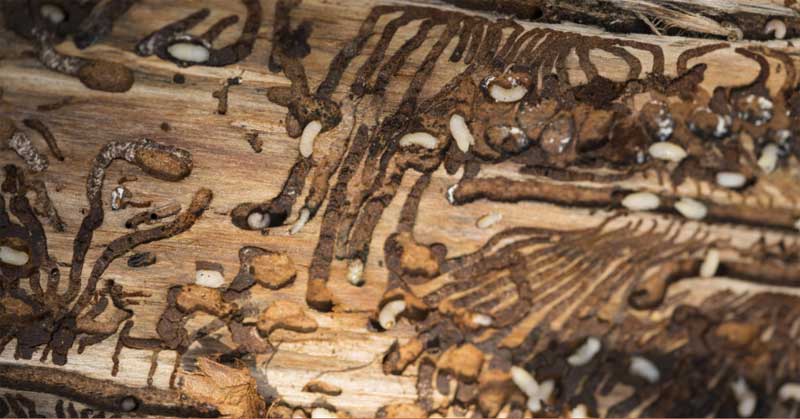Are you concerned about termites infesting your home? Wondering if these tiny pests can move between houses? Look no further!
In this comprehensive analysis, we delve into the behavior of termites in house-to-house transfer and the factors that influence their movement. We explore common entry points and the role of colonies in spreading.
Plus, we provide effective strategies to prevent termite infestations in multiple houses. Don’t let termites take over your neighborhood – arm yourself with knowledge!
The Behavior of Termites in House-to-House Transfer
Termites can easily move between houses and termites will definitely bite humans, posing a significant threat to neighboring properties. They have the ability to sense changes in temperature, humidity, and food availability, allowing them to navigate through various obstacles. Termites can travel through soil, walls, and even electrical wiring to find their way into new structures.
However, human activities also play a crucial role in termite movement between houses. Construction and landscaping practices that disturb the soil or create moisture problems can attract termites and facilitate their movement. Improper storage of wood and debris near houses can provide a direct pathway for termites to infest neighboring properties.
Therefore, it is essential to implement preventive measures and regular inspections to minimize the risk of termite transfer between houses.
Factors Affecting Termite Movement Between Houses
You’ll want to consider certain factors that can influence how easily these pests travel from one home to another. Here are some key factors to keep in mind:
- Proximity: Termites are more likely to move between houses that are in close proximity to each other.
- Connectivity: If houses share common walls, roofs, or underground tunnels, termites can easily move between them.
- Infestation level: If one house is heavily infested with termites, it increases the chances of them spreading to neighboring houses.
- Construction materials: Certain types of building materials, like wood, can attract termites and facilitate their movement between houses.
- Climate: Termites thrive in warm and humid environments, so houses in such climates are more prone to termite infestations.
To prevent termite movement between houses, consider implementing these strategies: regular inspections, sealing cracks and crevices, keeping wood away from the foundation, maintaining proper ventilation, and using termite-resistant construction materials.
Common Entry Points for Termites in House-to-House Migration
One of the main factors affecting the ease of termite migration between houses is the proximity of the homes to each other. If houses are located close together, termites can easily move from one house to another, increasing the risk of infestation.
It is important to be aware of common entry points for termites in house-to-house migration. These entry points include cracks in the foundation, gaps around windows and doors, and even through plumbing and electrical conduits.
Regularly inspecting your home for signs of termite infestation, such as mud tubes, discarded wings, and wood damage, is crucial for early detection.
If you suspect termite activity, it is recommended to contact a professional pest control company that can provide effective termite control methods to eliminate the infestation and prevent further damage to your home.
Understanding the Role of Colonies in Termite Spreading
Understanding the role of colonies in termite spreading is essential for effective termite control and prevention. Termite colonies are highly organized societies with specific roles and responsibilities for each member. To give you a better understanding, let’s take a look at the colony dynamics and communication mechanisms in a table format:
| Colony Dynamics | Communication Mechanisms |
|---|---|
| Division of labor | Pheromone trails |
| Reproductive caste | Vibrations |
| Worker caste | Antennation |
| Soldier caste | Trophallaxis |
| Queen caste | Contact |
These colony dynamics allow termites to efficiently spread and establish new colonies. Communication mechanisms like pheromone trails, vibrations, antennation, trophallaxis, and contact play a crucial role in coordinating their activities and ensuring the survival of the colony. By understanding these mechanisms, we can develop better strategies for termite control and prevention, disrupting their communication and ultimately reducing their spread between houses.
Effective Strategies for Preventing Termite Infestations in Multiple Houses
To effectively prevent termite infestations in multiple houses, it’s important to implement regular inspections and maintenance.
By regularly inspecting your homes, you can identify any signs of termite activity early on and take necessary actions to prevent further damage. Regular inspections allow you to catch any potential termite problems before they become widespread and harder to control.
In addition to inspections, regular maintenance is crucial in termite control. Keeping your houses well-maintained, with no moisture leaks or wood-to-ground contact, reduces the risk of termite infestations. Implementing termite control methods, such as using treated wood and installing physical barriers, can also help in preventing termite attacks.
Frequently Asked Questions
How Long Does It Take for Termites to Move From One House to Another?
On average, it takes termites some time to move from one house to another. The speed at which they move can be influenced by various factors.
These factors may include the distance between the houses, the availability of food sources, and the size of the termite colony. Understanding these factors can help you determine how long it might take for termites to move between houses.
Can Termites Transfer From One House to Another Through Underground Tunnels?
Yes, termites can transfer from one house to another through underground tunnels. These tunnels are efficient pathways for them to move between houses, allowing them to access new sources of food and expand their colonies.
It is important to note that termite prevention methods may not always be effective in stopping their movement through these tunnels. Therefore, it is crucial to implement multiple prevention strategies to minimize the risk of termite infestation.
Do Termites Prefer Certain Types of Houses Over Others When Migrating?
When it comes to termites’ house preference, there are several factors that influence their migration. These factors can include the type of wood used in the construction of the house, the moisture levels in the surrounding environment, and the availability of food sources.
Termites are attracted to houses that provide them with favorable conditions for survival and reproduction. So, it is possible that termites might prefer certain types of houses over others when migrating.
Are There Any Specific Times of the Year When Termite Migration Between Houses Is More Likely to Occur?
During certain times of the year, termite migration between houses is more likely to occur. Factors like weather conditions and availability of food sources play a role in influencing their movement patterns.
Environmental changes, such as fluctuations in temperature and moisture levels, can also impact termite movement between houses.
Understanding these factors can help homeowners take preventive measures to protect their properties from termite infestations.
Can Termites Move Between Houses Located in Different Geographical Areas or Climates?
Yes, termites can move between houses located in different geographical areas or climates. Termite migration patterns are influenced by various factors, including climate. They are capable of traveling long distances to search for new food sources and suitable habitats.
Therefore, it is possible for termites to infest houses in different areas, as long as the conditions are favorable for their survival. The impact of climate on termite movement is crucial in understanding their ability to spread and cause damage.
Conclusion
So, there you have it. After a comprehensive analysis, it is evident that termites can indeed move between houses.
Various factors, such as proximity, environmental conditions, and the presence of colonies, play a significant role in termite migration.
Understanding common entry points and implementing effective prevention strategies is crucial in preventing termite infestations in multiple houses.
By taking the necessary precautions and understanding termite colonies, you can protect your home and ensure that these destructive pests stay far away from your property.

